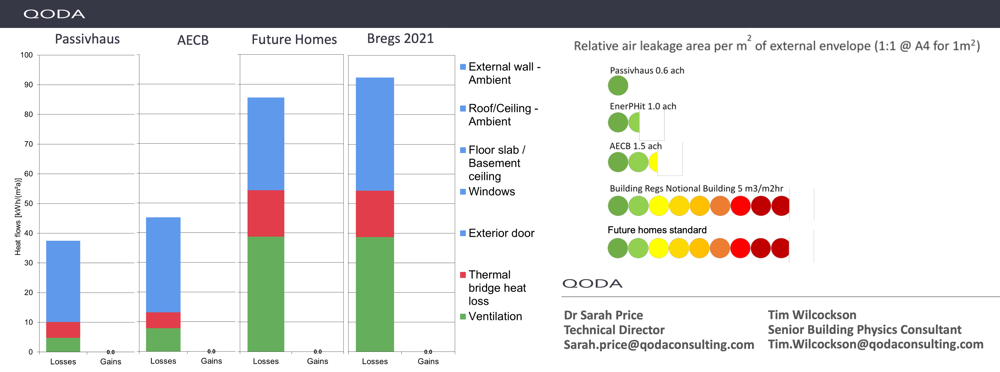Future Homes Standard, solar and potential shortfalls
Contents |
[edit] FHS, HEM and solar
The Future Homes Standard (FHS) is a planned obligatory standard for all new homes that aims to reduce carbon emissions by 75–80% compared to current UK regulation requirements. Intended to come into force in 2025, it will introduce a new way of calculating how the standard is met, using the new Home Energy Model (HEM) with a component called the FHS wrapper for domestic buildings. However, the government recently announced that at least initially both SAP 10.3 and the HEM with the wrapper may be used to assess compliance.
A key element of the new standard will be to prevent new buildings from having gas boilers, with only low- or zero-carbon heating systems being allowed - the majority of which are likely to be heat pumps.. The Government announced in July 2025 that a change to the standard will mean that all new homes will also be required to include solar (subject to practical limits in terms of trees or excessive shading).
[edit] Will the requirements go far enough ?
By going fully electric, the standard talks about being "zero carbon ready", which means that with some energy produced on site (by solar), the rest (or most) of the buildings' electricity use would become zero carbon when the national electricity grid is fully de-carbonised. In September 2024, the Microgeneration Certification Scheme (MCS) published its report."Future Homes Savings: Modelling the running costs of new homes with renewables", which looked into the cost benefits of adding the requirements for solar.
Other aspects required to meet the standard include improvements in the fabric of buildings, such as walls and window performance (U values), improved air tightness and so on. However, prior to the publication of the consultation as early as May 2022, some argued that whilst there were improvements in fabric requirements, they were not considerably more than is currently required by the building regulations. Dr Sarah Price and Tim Wilcockson of QODA Consulting presented an AECB webinar on an overview of the Part L updates and a quick look at the Future Homes Standard in 2025, comparing FHS, Passivhaus, the AECB standard and Part L 2021. (see below slides can be downloaded here)
The criticism at the time was in the consideration that has been given to thermal bridging, air tightness and ventilation, where many advocate for Mechanical Ventilation Heat Recovery (MVHR); the new standard remains a naturally ventilated solution. The graph above by QODA for AECB highlights these discrepancies, where the blue losses show relatively similar amounts, whilst the red and green sections representing thermal bridging and ventilation are more than double in Part L and the FHS as they are in Passivhaus or the AECB standard. The diagram to the right of this highlights the considerable difference in the air tightness requirements between the two sets of standards.
Following an initial letter, on 17 October 2024 a group of the authors (Bioregional, Good Homes Alliance, LETI, and UKGBC) met with Baroness Taylor, Parliamentary under-secretary of state at MHCLG, to discuss concerns they had with the proposed options and the FHS. Following this meeting, the coalition sent a follow up letter clarifying key points and asking for a formal response. Some of these points included the need to regulate embodied carbon in new buildings, improve the fabric standards for U values and air tightness, improve new home ventilation systems and reduce electricity generation investment required.
In March 2025 the UK Passivhaus Trust published their report "Passivhaus compared to the proposed FHS 2025: PHT Position Paper", which highlights some of the similar points brought up by the earlier letter, regarding fabric performance. As a result the Trust also publsihed their postion paper suggesting "Passivhaus as an alternative means of compliance to the FHS". The introduction of mandatory solar for the FHS in June suggests that revisions are likely to be made to the requirements of the FHS before it becomes mandatory in the Autumn, what is not clear is exactly what these revisions will be.
[edit] Calculation methods
It seems the FHS may eventually continue to allow the use of both SAP 10.3 and HEM with the wrapper. The assumptions that will be made by wrappers, in order to assess if the standard is met represent a variety of data input sets which might include factors such as occupancy patterns, local weather, building standards and potentially white goods, airtightness, and ventilation. The idea being that the HEM is more sophisticated that previous tools such as SAP, being more detailed and flexible enough for a range of buildings, whilst the wrapper helps to simplify the process so it can be applied more widely.
The Future Buildings Standard (FBS) will on the other hand will most likely continue to use a combination of different energy performance modelling tools; such as Dynamic Simulation Models (DSMs) and the most recent update of Simplified Building Energy Model (SBEM). The current version is iSBEM_v6.1.e, and it can be used for the purposes of: assessing compliance with 2021 ADL V2 in England and generating England EPC.
In terms of existing residential building, ijn February 2024, BRE released the specification for RdSAP10, which offers a more detailed and accurate assessment of energy performance in existing dwellings. RdSAP10 aligns more closely with the full SAP method used for new builds by expanding reduced data into a full dataset before running the calculation. This updated version is now part of the SAP 10.2 specification and helps enhance the accuracy of EPCs for existing homes, but this currently remains separate from the FHS. In the case of existing buildings the standards are being raised by slowly requiring all existing buildings to achieve an EPC performance rating of C rather than use the FHS.
[edit] Background
In 2021, under the conservative government a consortium of experts led by the BRE were appointed to carry out a multi-year project to develop a replacement for the Standard Assessment Procedure (SAP). In December 2023 the consultation 'The Future Homes and Buildings Standards: 2023 consultation' was published along with the 'Home Energy Model (HEM): Future Homes Standard assessment' on the same day.
The proposed Future Homes Standard would see building regulations amended to explicitly promote solar for the first time, subject to practical limits with flexibility in place for new homes surrounded by trees or with lots of shade overhead. Under proposed changes, new homes will also have low-carbon heating, such as heat pumps and high levels of energy efficiency, cutting people’s energy bills and boosting the nation’s energy security with clean, homegrown power, in line with the Prime Minister’s Plan for Change.
From switching on the kettle to cooking dinner and doing the weekly wash, families will now be able to seize the benefits of powering their lives with clean, renewable energy from the very first day in their new home, with cheaper energy bills that put more money back in their pockets, the government said.
The intention is that this approach be used to replace the most recent SAP version 10.2 for the energy rating of new dwellings, though the approach for existing dwellings (RdSAP) was not explicitly discussed in the consultation. The update to RdSAP (RdSAP 10), initially expected in 2024 and now expected to be available in 2025, was anticipated to significantly improve on previous versions. It aims to have a number of upgrades, including new technologies, protocols for datacollection, detailed recommendations, and better carbon emissions assessments, which would then be incorporated into an EPC, and feed into other government funding schemes such as the Boiler Upgrade Service (BUS).
[edit] Related articles on Designing Buildings
- BRE Group response to the Future Homes Standard consultation.
- BRE response to the green housing revolution.
- Building Beautiful Places plan.
- Building Better, Building Beautiful Commission interim report.
- Building Better, Building Beautiful Commission.
- Changes to Building Regulations Part F.
- Consortium issues urgent call for more ambitious Future Homes Standard.
- EPC changes for existing buildings.
- Getting zero carbon done.
- Future Buildings Standard.
- Future Buildings Standard shortcomings raised.
- Future Homes Standard consultations.
- Green Housing Revolution.
- Home design prospects under the Future Homes Standard.
- Home Energy Model.
- Hybrid heat pump electric panel heating.
- Is hydrogen the heating fuel of the future?
- National Design Guide.
- Pilot programme for National Model Design Code NMDC.
- The effects of subframe systems on the overall thermal performance of external rainscreen walls.
- The EPC consultation in the context of changes to the NCM.
- The Home Energy Model and Future Homes Standard assessment wrapper.
- Thermal bridging and the Future Homes Standard.
Featured articles and news
The UK’s largest air pollution campaign.
Future Homes Standard, now includes solar, but what else?
Will the new standard, due to in the Autumn, go far enough in terms of performance ?
BSRIA Briefing: Cleaner Air, Better tomorrow
A look back at issues relating to inside and outside air quality, discussed during the BSRIA briefing in 2023.
Restoring Abbotsford's hothouse
Bringing the writer Walter Scott's garden to life.
Reflections on the spending review with CIAT.
Retired firefighter cycles world to raise Grenfell funds
Leaving on 14 June 2025 Stephen will raise money for youth and schools through the Grenfell Foundation.
Key points for construction at a glance with industry reactions.
Functionality, visibility and sustainability
The simpler approach to specification.
Architects, architecture, buildings, and inspiration in film
The close ties between makers and the movies, with our long list of suggested viewing.
SELECT three-point plan for action issued to MSPs
Call for Scottish regulation, green skills and recognition of electrotechnical industry as part of a manifesto for Scottish Parliamentary elections.
UCEM becomes the University of the Built Environment
Major milestone in its 106-year history, follows recent merger with London School of Architecture (LSE).
Professional practical experience for Architects in training
The long process to transform the nature of education and professional practical experience in the Architecture profession following recent reports.
A people-first approach to retrofit
Moving away from the destructive paradigm of fabric-first.
International Electrician Day, 10 June 2025
Celebrating the role of electrical engineers from André-Marie Amperè, today and for the future.
New guide for clients launched at Houses of Parliament
'There has never been a more important time for clients to step up and ...ask the right questions'
The impact of recycled slate tiles
Innovation across the decades.
EPC changes for existing buildings
Changes and their context as the new RdSAP methodology comes into use from 15 June.


























Comments
Add your comments here.